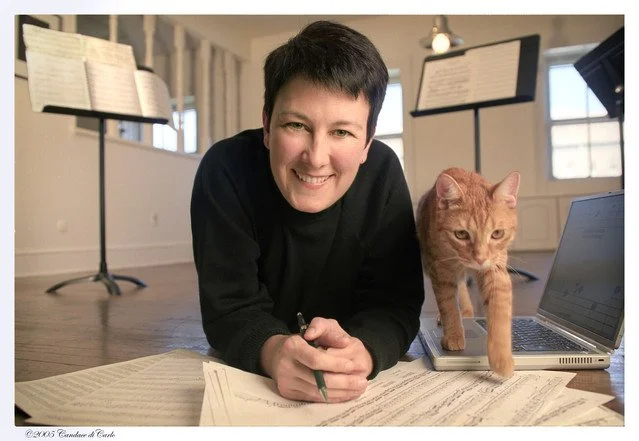Composers You Should Know: Jennifer Higdon
by Oumar Signa & Quentin DeracJennifer Higdon, AMERICAN COMPOSER
BORN: December 31, 1962RAISED: Brooklyn, New York, USAJennifer Higdon (b. December 31, 1962, New York) is one of today’s most widely performed American composers, celebrated for music that speaks directly to audiences through color, emotion, and clarity. A Pulitzer Prize and three-time Grammy Award winner, Higdon’s work combines luminous orchestration with lyrical, memorable melodies that bridge accessibility and innovation. From the shimmering blue cathedral (1999) to her Violin Concerto (2008) and Concerto for Orchestra (2002), Higdon’s compositions have become cornerstones of the 21st-century repertoire—championed by major ensembles around the world and admired for their emotional immediacy and radiant textures.
Early Life & Education
The daughter of a painter, Higdon grew up surrounded by art and experimentation. Yet her introduction to classical music came relatively late. In high school, she began playing flute and percussion, performing in concert and marching bands. During her undergraduate studies in flute performance at Bowling Green State University, a professor encouraged her to try composing—despite her lack of formal training. As she later recalled,
“I didn't know any basic theory, how to spell a chord, what intervals were, and I had zero keyboard skills... I basically started from the very, very beginning.”
Through determination and curiosity, Higdon developed a unique musical voice shaped by intuition as much as by formal study.
She went on to earn her Artist Diploma at the Curtis Institute of Music, studying with David Loeb and working closely with Ned Rorem, whose lyricism and clarity of expression left a lasting influence. At the University of Pennsylvania, she completed her master’s and Ph.D. under George Crumb, whose experimental approach opened new creative dimensions. These experiences helped Higdon merge technical rigor with a belief that modern composition could balance complexity, nature, and emotional resonance.
Higdon (left) in her early 20s, with flute teacher Judith Bentley, in 1983 at Bowling Green State University in Ohio.
Musical Style & Innovation
Higdon’s neo-romantic style reflects her ability to draw on the expressive intensity of earlier eras while writing in a distinctly modern voice. Her music is direct, intuitive, and deeply human—often inspired by personal experience and the natural world. Works like On a Wire (2010), written for the sextet Eighth Blackbird, evoke the flight of birds through innovative timbral techniques such as bowed piano strings. In All Things Majestic (2011), inspired by the grandeur of America’s national parks, Higdon captures vast landscapes in sound, marrying traditional harmonic warmth with striking modern textures. Her music invites listeners into vivid sonic worlds where color, motion, and emotion coexist seamlessly.
Higdon in her studio in 2010, when she lived in Philadelphia. She composes up to six hours a day, seven days a week.
Major Works
blue cathedral (1999)
Commissioned by the Curtis Institute of Music in memory of Higdon’s brother, blue cathedral remains her most beloved work. The composer describes it as “the expression of the individual and the group... our inner travels and the places our souls carry us.” The piece unfolds from a quiet, reflective opening to a radiant climax before dissolving into serenity, its flute and clarinet lines—played on the instruments she and her brother once played—intertwining in a tender musical farewell.
Piano Trio No. 1, Pale Yellow (2003)
The first of two trios, Pale Yellow explores the relationship between sound and color. Its shimmering textures and gentle lyricism evoke the calm glow of its namesake hue, creating an atmosphere of light introspection and balance. See it performed live on Friday, October 17, 2025 at our Season Two concert, Pale Yellow.
Influence, Legacy, and Cultural Impact
Through her fearless blending of modern technique and emotional accessibility, Jennifer Higdon has expanded the possibilities for contemporary orchestral and chamber music. Her works have encouraged ensembles and audiences alike to embrace new music as something both adventurous and inviting. Equally important, she stands as a model for diversity and representation in composition—showing future generations that great art can be innovative without abandoning its emotional heart.
Conclusion
Jennifer Higdon has redefined what it means to be a modern American composer. Her music, which is radiant, compassionate, and endlessly inventive, reminds us that the most lasting art connects not through complexity alone, but through the shared language of feeling.
Programs Featuring Jennifer Higdon’s Compositions:
Links
Jennifer Higdon Official Website
Your Classical | Women's History Spotlight: Jennifer Higdon
Bethany Writes | Music Spotlight: Jennifer Higdon
The Pennsylvania Gazette: “Shine” Puts Young Composer in the Spotlight
Cape Code Times: Higdon breaks the mold for composers
Bowling Green State University: Dr. Jennifer Higdon ’86, ’14 (Hon.)
Jennifer Higdon: Don’t Look Back! via Susan Gabriel
Civitella Ranieri: Jennifer Higdon
Pulitzer Prize-Winning Composer Jennifer Higdon Visits Montclair State
I Care If You Listen: 5 Questions to Jennifer Higdon (composer)














